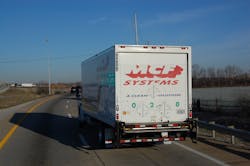ATRI study start of effort to “disaggregate” truck crash data
A newly released study from the American Transportation Research Institute (ATRI) represents the first phase of what the group hopes will boost truck safety by separating or “disaggregating” medium- and heavy-duty truck crash data.
Dan Murray, ATRI’s VP-research, told Fleet Owner that the group’s analysis of a decade worth of truck crash data, spanning from 2000 to 2010, revealed noticeable differences in safety trends between different truck sizes, with medium-duty generally performing worse than heavy-duty trucks.
“The good news here is that heavy-duty truck safety is actually better than we thought,” he explained. “But the bad news, which borders on disturbing, is that combining medium- and heavy-duty crash statistics has masked a high level of medium-duty truck crash rates.”
The study – entitled Large Truck Safety Trends and authored by Lisa Park and David Pierce, both ATRI research associates based in Atlanta, GA – divided crash data by truck type into medium-duty (Class 3-6) weighing between 10,001 and 26,000 lbs. plus heavy duty (Class 7-8) weighing 26,001 lbs. and above.
The group also developed what it calls a “crash rate index” or CRI to track specific variables such as vehicle type, crash location, and weather to determine the degree to which certain factors influenced crash trends for medium- and heavy-duty trucks.
Based on its analysis, ATRI found that:
- Whereas heavy-duty trucks have generally experienced a decline in CRI of 24.6% between 2000 and 2010, medium-duty duty trucks have seen a 38.3% increase over that same 10 year period;
- Non-interstate carrier crashes exhibited a steep increase in CRI compared to interstate carriers, particularly among medium-duty truck crashes.
- Increases in medium-duty truck crashes on roads in urban core counties were responsible for much of the increase in medium-duty CRI numbers;
- Adverse weather conditions had somewhat of an equalizing effect, reducing the differences between medium- and heavy-duty truck CRIs.
Murray said ATRI is now focused on “drilling down” further into the crash causation data for both truck types to help determine what specific tactics can help boost safety trends for each class of commercial vehicle.
“This report will form the starting part for a broader effort to ‘customize’ safety solutions for each type of truck,” he explained. “For if we know the critical factors affecting crash rates for each type of truck, we can recommend curriculum for driver schools and even specific scenarios for driver simulator systems.”
Murray noted that the medium-duty segment of the trucking industry – particularly drivers of such vehicles – might also begin to see more attention from government agencies and safety groups as a result of such crash analysis.
“The medium-duty segment has not been on most people’s radar screens to date, but now it will be,” he stressed. “As a result, medium-duty driver might begin to feel like they’re under a microscope. But in the end this focus will be helpful to everyone, the general public and trucking firms alike, as it should help reduce crash rates.”
About the Author
Sean Kilcarr
Editor in Chief
Sean Kilcarr is a former longtime FleetOwner senior editor who wrote for the publication from 2000 to 2018. He served as editor-in-chief from 2017 to 2018.
